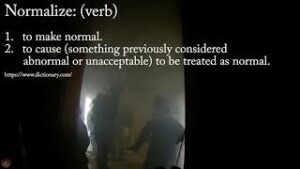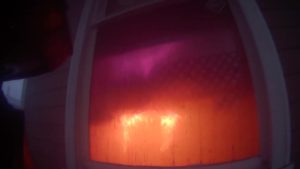This is part of a series of training burns designed by one of our instructors, Jay Bonnifield. These were not done under the West Coast Fire Training banner but he wanted to share them on this page. These burns were for Snohomish County Academy instructors only. The experience of the participants allowed for more difficult pushes. No student would be asked to make this push until they had demonstrated proficiency with the technique required in a clean environment and had made successful pushes on grade in live fire. Below are Jay’s comments regarding the event.
Side by side footage of a push down stairs to a room fire in a split level. A couple of things stood out on this one:
1: Split entry/level houses can be really deceiving. The right side of the video shows really briefly there is fire rolling all of the way up in the living room from the lower level. You could easily see why it can be mistaken that the fire is in the upper part of the house when it is actually lower, especially at night where stagnant lower-level smoke may not be as visible. The heat levels in the living room and upper bedrooms were also very high compared to a normal multi-story home. It definitely reinforces the mindset that we have to own the stairs with the line.
2: Pace is key on downstair pushes. Obviously, if conditions allow, bombing to the bottom and setting up shop would be ideal, but that just isn’t always an option. Being able to advance slowly and calmly with a good lean back and sounding the stairs as you go is key (nozzle forward dudes have it dialed in if you want to get good at it). Right before the nozzle drops down in the stairs the living room area gets some water, then the stream is moved into the stairwell and the stream reach is maximized to try to get water into as much of the lower level as possible on the way down.
I think downstair pushes exemplify engine company work. They may be one of the greater tests a crew can face and it forces a thinner margin of error for your technique. Most of the fires I wish I could do over again in my career so far have been because of below-grade fires in some capacity. Nozzle movement is key here, if you have a hard time separating what your lower body is doing from your upper body, aka you put so much thought into sliding down the stairs that your nozzle movement decreases down to a laser beam, then you will likely take a beating. Being conscious about the shape of the ceiling sloping down away from you and being able to keep water on the upper part of the opening while reaching as far down as it will go definitely helps stuff the exhaust.
Upstair pushes remind me a lot of truck work. Visually appealing and a lot of people are able to see it, but not actually that complicated ????. A downstair push is the definition of engine work to me. Its complicated, hot, dirty, and almost nobody will be able to see your handy work and truly appreciate it as you disappear into the darkness below. But everyone knows in their gut who made the big difference on that fire.



